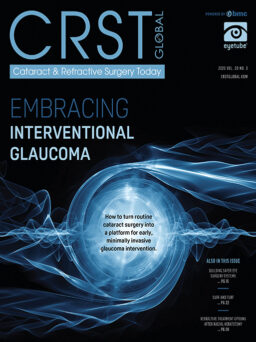1.What do you enjoy most about being an ophthalmic surgeon?
Ophthalmology is the art of preserving or improving our patients’ sight. Ophthalmology—and particularly ophthalmic surgery—is one of the most innovative fields, and I enjoy being a part of it. It gives me special satisfaction to help my patients and to look into their happy eyes after successful treatment. It is now routine for experienced surgeons to have patients seeing well the first postoperative day, but I can remember back to when I was a resident and this was not the case. Every day I work to become better at what I do.
2.What do you consider to be the most exciting surgical development that you have been a part of and why?
I have been involved in several developments in anterior and posterior segment surgery, but the most exciting work I was a part of was the development of a device for canaloplasty. I have been performing viscocanalostomy since 1997, and I was excited about canaloplasty from the first moment I heard about this procedure. Since 2006, I have performed more than 150 successful 6-0 polypropylene-assisted canaloplasties, but this procedure is difficult and time-consuming. Previously there was no illuminated tip guiding the surgeon through the Schlemm canal. The iTrack (iScience Interventional, Menlo Park, California) was a big step forward, but the GlaucoLight (Dutch Ophthalmic USA, Exeter, New Hampshire) is even smaller, more economical, and has its own light source. We have been using this device for more than 1 year, and we are excited by how easy canaloplasty has become. Postoperative intraocular pressure is less than 15 mm Hg without any antiglaucomatous treatment in more then 50% of our cases. Additionally, there are no blebs and fewer complications overall.
3.What surgical cases do you find most enjoyable to perform and rewarding once successfully completed?
As I have performed more than 20,000 intraocular surgeries and I perform anterior and posterior surgery almost every day, routine cases are not so exciting anymore. I enjoy challenging cases with comorbidities and pole-to-pole surgery the most. It gives me great satisfaction to solve these problems and to preserve my patients’ vision even in extremely complicated situations.
4. How do you envision cataract surgery will change over the next 5 years?
Cataract surgery will be more concentrated in high-volume institutions. These centers will become multidisciplinary and will provide pole-to-pole surgery. New techniques such as laser refractive cataract surgery and optical coherence tomography-assisted surgery will become routine and will improve outcomes. But, as a result, the financial burden to ophthalmology will increase, and not all of our patients will have access to the latest technologies.
5.What do you consider your greatest personal experience outside your profession?
In 1989, when I was living in Berlin, I witnessed the fall of the Berlin Wall. For my generation, this change represented and offered nearly unlimited possibilities. I have enjoyed the past 20 years. Being half Hungarian and half German, I am glad to see that Europe has come together and old prejudices have been overcome.




